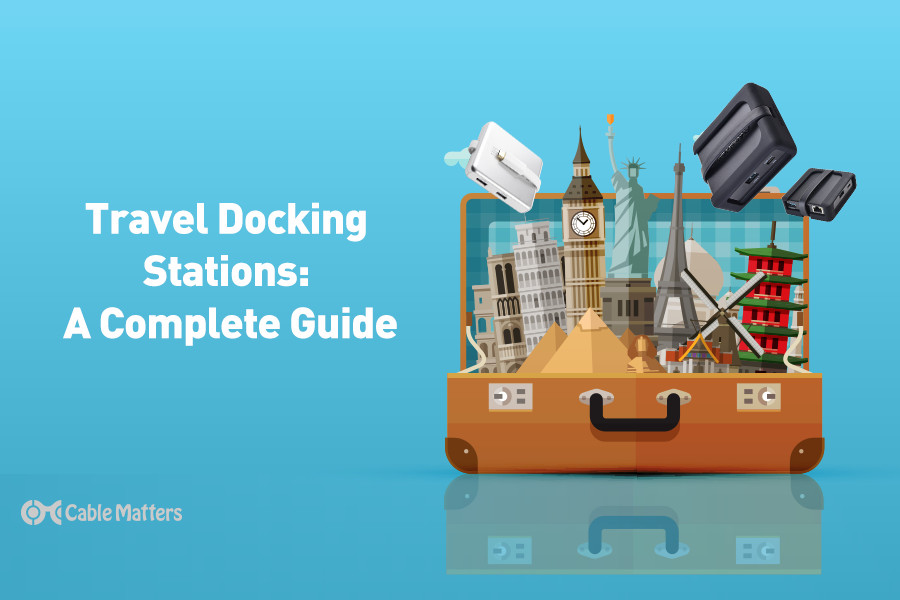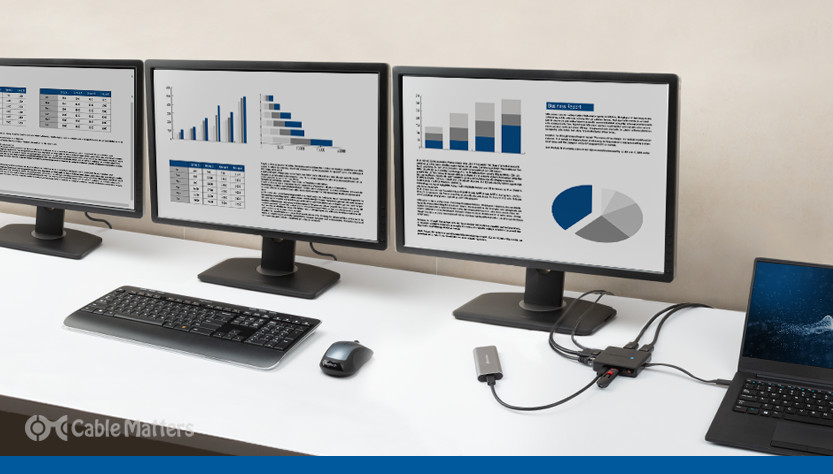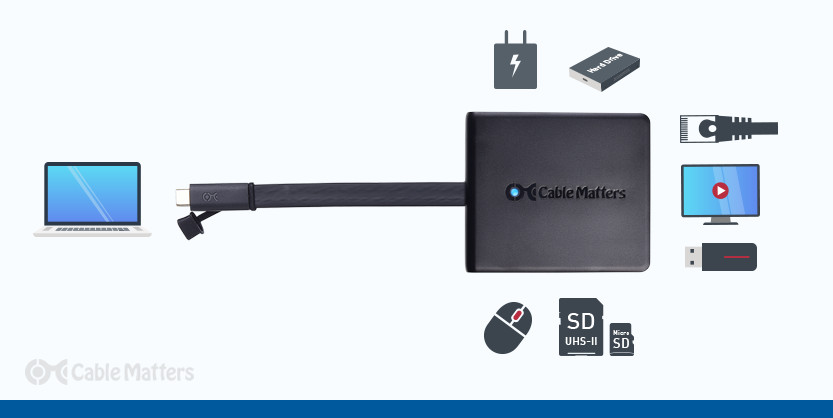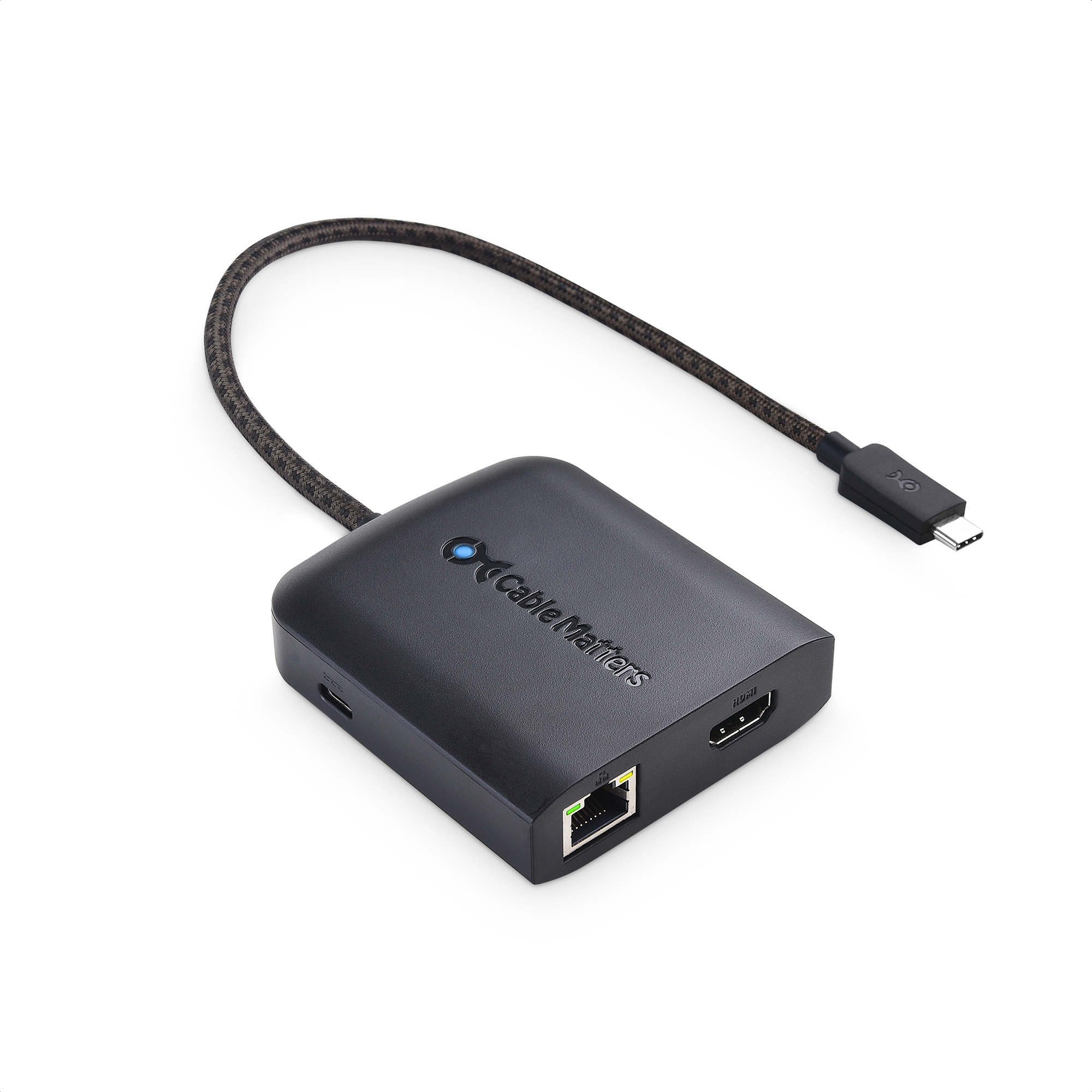
Most laptop docking stations are designed to be stationary pieces of equipment. To handle their huge array of ports and cable options, they typically demand external power and can be rather large and unwieldy. Not all docking stations are like that, though. There’s a class of portable docking stations that are designed to be used on the go, giving your laptop the additional ports and connections you need, wherever you are.
Let’s take a look at travel docking stations, what makes them different from more traditional docking stations, and why they might be the best way to augment your laptop when you’re traveling or moving back and forth between home and work offices.
What are Travel Docking Stations?
Docking stations, in general, are essentially small breakout boxes that give connected devices a much broader and expansive array of connection options. Where modern laptops might come fitted with just a few USB-C or Thunderbolt ports, a docking station can take that singular high bandwidth connection and branch it out to offer Gigabit Ethernet, an array of USB-A and USB-C connections, card reader slots of various sizes, headphone and microphone jacks, various video out connections for external monitors, USB Power Delivery ports, and more.
Not all docking stations are the same, though. There are grand, expansive ones that have every port under the sun, and there are smaller, more modest ones – that are typically more affordable too.
They all do roughly the same thing, however, and most docking stations are designed to sit at a static desk and give a connected laptop, desktop-like functionality. They’re for office workers who bring their laptop from home, plug in, and have a more functional system while they’re at their desk, whilst still letting them take their laptop with them for on-the-go work when away from it.
Travel docking stations aren’t drastically different from this, but they’re designed to be portable. That means no mains power demands and a compact and lightweight design. That does typically mean there are fewer port options on travel docking stations, but their selection is still robust. You just might need to buy a travel docking station that’s specific to your port needs, rather than getting a general one that has everything.
They can also be powered by the laptop you’re connecting them to. Travel docking stations are designed to use very little power to help avoid it draining the laptop’s battery excessively. That can be a factor to consider when it comes to the devices you connect to it, though. Charging your smartphone from the docking station is a no-brainer with a static, mains-powered docking station, but it takes more consideration with a travel docking station.
Most modern travel docking stations support USB-C Power Delivery, which means you can charge your devices via the docking station. Better yet, if you have a USB-C charger handy and your laptop supports it, your travel docking station can charge both your laptop and any attached devices. Some can even power external displays and transmit video and data over a single USB-C connection.
With Thunderbolt compatibility, there’s even the potential for ultra-high definition 4K and 8K displays, though you’ll need to be sure that your laptop is up to spec to run a system at those resolutions first.
The Benefits of Travel Docking Stations
Travel docking stations can do almost all of the things that static docking stations can. Their core function is to give your laptop a much greater array of port options, so laptops that are limited to a few USB-C or Thunderbolt connections will be able to take advantage of USB-A ports, a Gigabit Ethernet connection (up to 2.5 Gigabit in some cases), traditional 3.5mm audio jacks for headphones and microphone for attaching wired headsets, and a range of video outputs.

In some cases that can be as simple as adding additional USB-C connections, but some travel docking stations also offer HDMI and DisplayPort connections, providing access to a wider range of monitors and displays, with a greater scope for higher resolutions and refresh rates.
That goes for accessories and peripherals too. While USB-C and Thunderbolt connections are becoming more common for newer devices with detachable cables, mice, keyboards, older flash drives, and most legacy accessories all come with pre-attached USB-A cables or connectors. With many modern laptops eschewing USB-A in favor of USB-C and Thunderbolt connections only, travel docking stations can provide important compatibility for a whole range of accessories.
Even if your laptop comes with most of the ports you need for your regular accessories and devices, using a docking station can be a major time saver if you regularly move around with your laptop between offices, or when at work or home. Instead of having to plug and unplug all of your accessories, displays, and other devices every time you want to change locations, you can simply unplug the docking station instead.
Travel docking stations might be designed to be portable, travel-friendly devices, but that doesn’t mean they have to be constantly on the go. Set them up at the start of your day while you’re working, and then take them with you at the end of the day when you want to bring those connections home with you.
They offer all the convenience of a traditional docking station, with the added benefit of being far more portable themselves.
USB-C Travel Docking Stations
The latest travel docking stations are almost universally USB-C devices. This has a number of benefits, not least because the USB-C connection is reversible and therefore far easier to use day to day. USB-C cables have the potential to offer much greater bandwidth than traditional USB-A connections, especially if they meet USB-C, Thunderbolt 3, or Thunderbolt 4 specifications. They also have access to the latest USB Power Delivery specifications, opening up the potential for device charging at much greater speeds than traditional USB-A connections.
Another important factor is how universal USB-C is slowly becoming. Along with seeing increased adoption on most modern laptops and tablets, it’s likely to see universal adoption on upcoming smartphones. A European Union provisional agreement recently mandated that all companies selling USB-chargeable devices must use the same standardized USB-C connection. Although it’s not finalized, that is the writing on the wall for proprietary charging standards, and should hasten an end to Apple’s Lightning charge ports, as well as older Micro-USB charging ports which are still found on a wide range of electronic devices in 2022.
USB-C travel docking stations are merely following the trend and will be just one type of USB-C accessory you can plug into your mobile computing devices in the future.

When You Need a Travel Docking Station
There isn’t an enormous difference between travel docking stations and more traditional docking stations: they’re all docking stations after all. However, there are some particular instances where a static, mains-powered docking station just won’t do, or you may find that a travel docking station is much more useful than the tethered alternatives.
If you’re going on vacation, a travel docking station lets you bring a wide range of ports and connections with you so that you have everything you need for connecting cameras for travel photos, as well as portable or solar chargers. You never know what kind of TV you’ll have in the room you’re staying in, so bringing along a travel docking station guarantees you’ll have the ports you need to stream movies from your laptop straight to the TV.
A travel docking station can also be particularly useful if traveling abroad where a different power plug is necessary. Using a travel docking station with USB Power Delivery allows you to charge all of your mobile devices from the docking station plugged into a single USB-C charger. That cuts back on the number of power adapters you need to bring with you, making packing and planning for your vacation that bit easier.
The same goes if you’re traveling for work, too. You’ll already have brought with you all of the devices you need to complete the job at hand, why not simplify your packing a little by just bringing the single charger? Better yet, if you need to travel between several work locations and a different office or trade show floor, then a travel docking station is far easier to bundle up and take with you than a more traditional dock.
Have security concerns about using the hotel’s free Wi-Fi? You should. Bringing a travel docking station means you’ll have Ethernet access so you can avoid the potential for man-in-the-middle attacks and data snooping, whatever it is you’re doing online.
Even if you aren’t traveling abroad, if you’re working away from your normal office for any reason, a travel docking station can be a very useful tool for all the same reasons. Sure you might not need to worry about power adapters, but being able to easily connect to whatever display you end up being near is a real boon. It never hurts to improve your laptop’s compatibility if you don’t know what kind of hardware you’ll have access to.
You could do that with a traditional docking station, but travel docking stations are far more convenient, especially if you’re visiting multiple locations where it could be useful in a short period of time.
That goes for students, too. If you need multiple devices, accessories, or peripherals to complete school work, or to show a presentation, then having a travel docking station makes sure that no matter what accessories or media you need access to in order to finish your work, you’ll have them to hand, whether you’re at school, college, or working at home.
Modern office software makes collaboration and cooperation between workers easier than ever, but sometimes you just need to have shared access to certain hardware. A travel docking station can make it easier to get onto local networks with an Ethernet connection, or quickly provide another user with access to the same accessories and peripherals as you. Simply swap over the device that the docking station is connected to, and you swap over all your devices, too. No need for lots of plugging and unplugging.
What Travel Docking Station To Buy: Cable Matters USB-C Multiport Adapters

Cable Matters offers an excellent line of USB-C multiport adapters that you can use for all sorts of work and home office tasks. Each adapter is very compact and lightweight, making it easy to slip into a laptop bag or backpack, and despite its diminutive size, it has a range of useful and capable connection options.
The USB-C Multiport Adapter with 8K DisplayPort features a USB-C cable with Thunderbolt 3 compatibility for connecting to the host system, but expands that out into a pair of USB-A ports (one USB 3.0, and one USB 2.0). It also offers a DisplayPort 1.4 connector which supports Display Stream Compression and resolutions all the way up to 8K, so there shouldn’t be any restrictions on the kinds of external displays you can connect up to this docking station. It also comes with an Ethernet port which supports network speeds up to 480Mbps, and comes with an LED status indicator helping you to verify when a connection is made.
The final port is USB-C with Power Delivery 3.0 support, so it offers up to 100W charging for powering the host system and for fast-charging any accessories and other devices that you plug into the travel docking station.
It works with Windows, MacOS, Linux, and ChromeOS, so is fully compatible with all of the most popular operating systems, and is completely plug and play, so no drivers are required.
Alternatively, if you want to output to a greater number of displays, or specifically need an HDMI connection, Cable Matters also offers a USB-C Multiport Adapter with Dual HDMI which comes with twin HDMI ports for easily connecting multiple external monitors. Alongside them are a pair of USB-A 2.0 ports, an Ethernet connection, and a single USB-C port with Power Delivery 3.0 support and 60W charge capacity. Networking speed is limited to 100Mbps, but you still get the LED status indicator.
For the ultimate in speed, Cable Matters also offers a USB-C travel dock with Gigabit Ethernet, 5Gbps USB ports, 100W Power Delivery, and 8K HDMI.
To improve the portability of this little multi-port adapter, it also comes with a tethered protective cap that protects the USB-C header when in transit, and the whole device comes in a wrap-around protective case to further ensure it stays safe when you’re traveling.